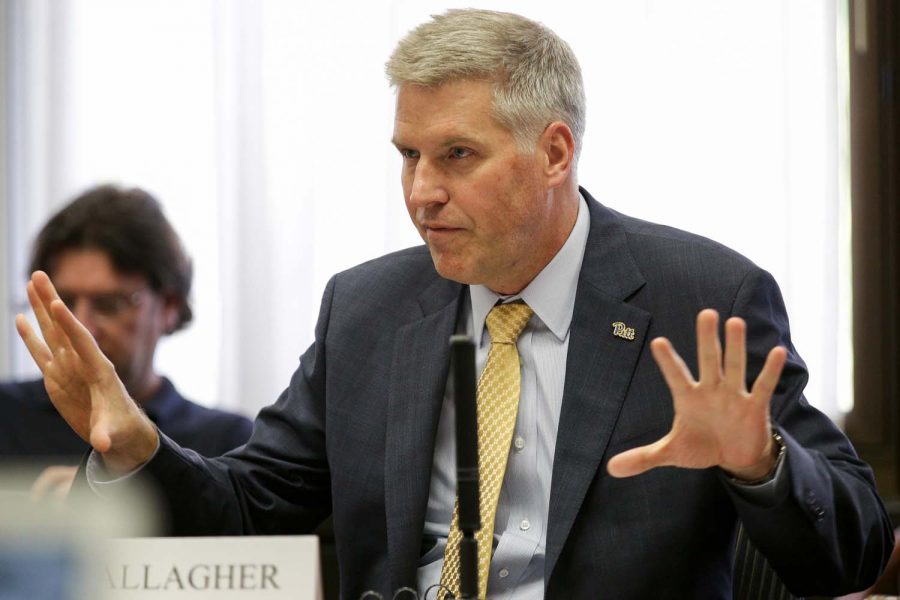Gallagher talks potential COVID-19 vaccine requirement, fall semester planning and more in TPN interview
Chancellor Patrick Gallagher at a Senate Council meeting.
May 3, 2021
At the end of a historic year during the COVID-19 pandemic, Chancellor Patrick Gallagher complemented the Pitt community for “leaning in together” and adjusting “on the fly” to make the year relatively successful.
“That sense of we’re all in this together, and the degree of flexibility and sacrifice and hard work that kind of made this year possible, mostly successfully,” Gallagher said. “I mean, you know, certainly we had infections, but we were really fortunate we did not have anybody get seriously sick. And I think, you know, the care was there.”
But Gallagher said while he doesn’t have a lot of “deep regrets” and that Pitt mostly struck a “good balance” between education and flexibility, there’s “a million things” he would do differently. He added that Pitt could have done better on communication.
The University has had 1,397 students and 245 employees test positive since June 26, with 1,384 students and 242 employees recovered thus far. Cases peaked at the end of March, but have steadily decreased following a shelter-in-place order.
Gallagher reflected on Pitt’s performance during the pandemic in an interview with The Pitt News last Thursday. He also answered questions about planning for the fall semester, potentially requiring a COVID-19 vaccine and the University’s recently released strategic plan framework.
COVID-19 Vaccine Requirement
More than 100 colleges and universities across the country have said they will require all students to get a COVID-19 vaccine before returning to campus for the fall semester, according to CNN. While most of the schools adopting this policy are private, some are public. Pitt has not made any decisions yet about a requirement. The Faculty Assembly introduced a proposal in mid-April that would require students to get vaccinated in order to participate in on-campus activities next fall, but didn’t take a formal vote.
Gallagher said setting a requirement is complicated because the vaccines are still under emergency use authorization from the U.S. Food and Drug Administration. He said Pitt’s philosophy is that a requirement discussion is a “last resort issue.”
Instead, he said Pitt is encouraging everyone to get vaccinated because they are “a good thing” and “highly protective” regardless of whether or not there is an enforcement mechanism. Gallagher added that Pitt will likely notify certain segments of the Pitt population first of any decisions, namely students living in residence halls.
“If we get later, and it turns out that the public health officials are saying a requirement is the thing that makes a difference, then we’ll consider it, but I think right now, promoting it, making it highly available and education education, are our best strategies to promote as widespread vaccination rates as possible,” Gallagher said.
Fall semester
University officials indicated last month that they are planning for on-campus, in-person instruction for the majority of classes as well as “the full range” of on-campus living and activities for the fall semester. Gallagher said this doesn’t mean classes will entirely go back to the way they were pre-pandemic, though. He said classes will likely include more technology and asynchronous components, such as taping lectures.
“The hardest thing to do is to be all things to all people all the time, and that just leaves you with poorly designed courses and programs too. And we saw that with student satisfaction,” Gallagher said. “So now what you’ll see is a swing of the pendulum back to more intentionality, if you will, about how we design our curriculum to do our activities, but it’ll also be more flexible than it was back in 2019.”
Gallagher said this planning framework is based on the “assumption” of high vaccine availability and that “everybody who can be vaccinated will be or should be.” But he acknowledged that this planning is more difficult for international students — what he called “our most disrupted student population” — due to inequitable vaccine distribution internationally.
Gallagher didn’t have many specifics about how classes will be adjusted for this student population, but said he expects more information will be released during the second half of the summer.
“What I think is happening is that the faculty are working on the curriculum, the classes now. So some of those details it would be premature for us to essentially announce them … but we’re also sort of out of sequence and the fact that people signed up for classes and stuff,” Gallagher said. “The cart is before the horse a little bit.”
Plan for Pitt
Pitt released the framework for Plan for Pitt 2025 — a plan for University development and growth over the next five years — in mid-April. Pitt pushed back the plan’s release in the summer to incorporate its response to the COVID-19 pandemic, as well as strategies to strengthen racial equity on campus.
Gallagher said the plan has a heightened focus on the role Pitt plays in strengthening surrounding communities. He said many of the initiatives in the first year will focus on “community engaged work” and addressing uneven health outcomes in Pittsburgh, which he said became even more evident during the pandemic. He said the plan will also focus on making campus more “welcoming and inclusive and stronger” and increasing awareness of Pitt’s graduate and professional programs.
“I think our mission has never been more important,” Gallagher said. “I think knowledge, awareness and understanding are the key to most of the biggest challenges we face, and if anything, that seems to have become even more true.”
A previous version of this story quoted Gallagher as international students are Pitt’s “our most disruptive student population.” He said “our most disrupted student population.” The Pitt News regrets this error.



